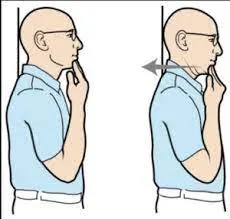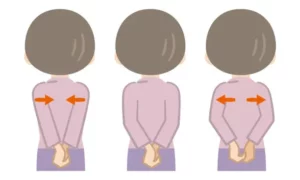Imagine a day where every tilt or turn of your head brings a sharp reminder of pain, constraining you from enjoying life’s simplest pleasures or even executing everyday tasks. Myofascial neck discomfort, a silent culprit, can creep into our lives, often undiagnosed or misunderstood. But, what if we told you that relief might just be a few exercises and self-care steps away? Dive in to uncover effective exercises and techniques to liberate yourself from the chains of myofascial neck pain and regain control over your well-being.
Contents
Understanding Myofascial Neck Discomfort
 At its core, the term “myofascial” is a fusion of two words: “myo“, referring to muscle, and “fascia“, the intricate web of connective tissue that envelops and supports our muscles and organs. To visualize the fascia, think of it as the thin, white layer that encapsulates a raw chicken breast. This continuous network of tissue, which spans throughout our body, plays a pivotal role in muscle function, movement, and posture.
At its core, the term “myofascial” is a fusion of two words: “myo“, referring to muscle, and “fascia“, the intricate web of connective tissue that envelops and supports our muscles and organs. To visualize the fascia, think of it as the thin, white layer that encapsulates a raw chicken breast. This continuous network of tissue, which spans throughout our body, plays a pivotal role in muscle function, movement, and posture.
However, due to a myriad of reasons – be it trauma, poor posture, or even prolonged stress – the fascia can become tight, sticky, and develop trigger points or “knots”. When these knots form in the neck region, they can restrict movement, cause muscle tightness, and lead to a persistent, aching pain. This localized pain stemming from the knots or adhesions in the fascia and underlying muscle is what we recognize as myofascial neck discomfort.
Not just limiting to pain, myofascial restrictions can impede blood flow, affect muscle performance, and even compress nerve pathways. As a result, individuals might experience not only pain but tingling, numbness, and muscle weakness in the affected region. Understanding this foundational concept is essential as it paves the way to explore tailored exercises and self-care routines that target and alleviate these fascial restrictions.
Root Causes of Myofascial Neck Pain
 The intricate interplay of factors that lead to myofascial neck pain often emerges from our daily routines, habits, and even our emotional well-being. Let’s unpack some of the primary culprits that can trigger or worsen myofascial discomfort in the neck.
The intricate interplay of factors that lead to myofascial neck pain often emerges from our daily routines, habits, and even our emotional well-being. Let’s unpack some of the primary culprits that can trigger or worsen myofascial discomfort in the neck.
- Muscle Overuse and Strain: Repetitive activities, such as typing for long hours or cradling a phone between your ear and shoulder, can strain the muscles in your neck, leading to the formation of trigger points.
- Postural Imbalances: The way we sit, stand, and carry ourselves impacts our muscle and fascial health. Poor posture, particularly when using electronic devices, can strain the neck muscles and create myofascial restrictions.
- Stress and Tension: Emotional stress often translates into physical tension. Chronic stress can cause muscle tightness and contribute to the formation of trigger points.
- Sleeping Position: Sleeping with your neck in an awkward position or on an unsupportive pillow can lead to strained neck muscles and myofascial pain.
- Repetitive Motions: Activities that involve repetitive motions, like playing a musical instrument, knitting, or painting, can strain certain muscle groups in the neck, leading to discomfort.
- Dehydration: Inadequate hydration can contribute to muscle stiffness and increase the likelihood of trigger points forming in the fascia.
- Injury or Trauma: A previous injury, such as a whiplash from a car accident or a sports-related trauma, can create myofascial restrictions that persist over time.
Understanding these underlying triggers helps us tailor our approach to managing myofascial neck pain. By addressing these root causes, we can adopt preventive measures and effective strategies to provide relief and improve our overall neck health.
Immediate Self-Care Remedies
 When myofascial neck discomfort strikes, swift and simple actions can make a significant difference in alleviating pain and tension. These immediate self-care remedies can offer you relief and help manage the discomfort in the moment:
When myofascial neck discomfort strikes, swift and simple actions can make a significant difference in alleviating pain and tension. These immediate self-care remedies can offer you relief and help manage the discomfort in the moment:
- Gentle Self-Massage: Using your fingertips, apply gentle pressure to the areas where you feel tension or knots. Gradually increase pressure as you feel the muscles begin to relax.
- Heat Therapy: Apply a warm compress or take a warm shower to help relax tight muscles and improve blood flow to the affected areas.
- Stretching: Perform gentle neck stretches to relieve muscle tension. Gently tilt your head from side to side, forward and backward, and rotate your neck clockwise and counterclockwise.
- Deep Breathing: Practicing deep, slow breaths can help relax not just your muscles but also your mind, reducing overall tension in the neck area.
- Hydration: Drink plenty of water to keep your muscles hydrated and help maintain muscle flexibility.
- Ergonomic Adjustments: If your pain is related to poor posture while working, make ergonomic adjustments to your workspace, including chair height and monitor placement.
- Mindful Relaxation: Engage in mindfulness techniques, such as meditation or progressive muscle relaxation, to release physical and mental tension.
Remember, these self-care remedies offer immediate relief, but for long-term management of myofascial neck discomfort, consider incorporating them into a comprehensive self-care routine.
Strengthening Exercises for Neck Support
Building strength in the muscles that support your neck is key to managing myofascial neck discomfort and preventing its recurrence. These exercises focus on improving your neck’s stability and promoting better posture:
Neck Retraction Exercise

Sit or stand tall. Gently tuck your chin in towards your neck, like creating a double chin. Hold for a few seconds and release. Repeat this movement to strengthen the muscles at the front of your neck.
Neck Extension Exercise

While sitting or standing, slowly tilt your head back to look at the ceiling. Hold for a few seconds and then return to the neutral position. This exercise targets the muscles at the back of your neck.
Isometric Neck Strengthening

Place your hand on your forehead and gently press your head forward while resisting with your neck muscles. Repeat by pressing your hand on the side of your head, then the back of your head.
Upper Trapezius Stretch

Gently tilt your head to one side, bringing your ear towards your shoulder. Use your hand to apply gentle pressure on the opposite side to enhance the stretch. Hold for 20-30 seconds on each side.
Scapular Retraction Exercise

Sit up straight and retract your shoulder blades by gently pulling them together. Hold for a few seconds, then release. This exercise helps improve your upper back strength, supporting your neck.
Chin Tucks with Resistance Band

Loop a resistance band around a sturdy object at eye level. Stand facing the band, and while holding the ends with both hands, gently perform chin tucks against the resistance.
Shoulder Shrugs

Elevate your shoulders towards your ears and hold for a few seconds before relaxing. This exercise strengthens the muscles around your upper back and neck.
Start with a comfortable number of repetitions and gradually increase as your strength improves. Remember to perform these exercises with controlled and deliberate movements.
Exploring Myofascial Release Therapy

Myofascial release therapy is a specialized technique designed to address fascial restrictions and promote healing within the body. Fascia, the connective tissue that surrounds muscles, bones, and organs, can develop tightness and restrictions due to various factors, leading to discomfort and limited mobility. Myofascial release therapy aims to alleviate these issues through specific manual techniques. Here’s how it works and how it can benefit individuals experiencing myofascial neck discomfort:
Understanding Myofascial Release:
- Hands-On Approach: Myofascial release therapy involves hands-on manipulation of the fascial tissue by a trained therapist. The therapist uses gentle pressure and stretching to release tension and restrictions in the fascia.
- Targeted Approach: The therapy focuses on identifying and targeting specific areas of fascial tightness. This can include trigger points, adhesions, and knots that contribute to discomfort.
- Slow and Sustained Pressure: The therapist applies slow and sustained pressure to the affected areas. This encourages the fascia to gradually release tension and return to its normal state.
Benefits of Myofascial Release
- Pain Relief: Myofascial release therapy can provide effective pain relief by releasing tension in the fascial tissue that may be contributing to discomfort.
- Improved Range of Motion: By addressing restrictions in the fascia, individuals may experience improved flexibility and range of motion in the affected area.
- Enhanced Circulation: The therapy can help enhance blood circulation in the targeted area, promoting healing and reducing inflammation.
- Stress Reduction: Myofascial release techniques can induce relaxation and stress reduction, contributing to an overall sense of well-being.
Sessions and Professional Guidance:
Myofascial release therapy typically involves multiple sessions to achieve optimal results. A trained therapist will assess your condition, target areas of tightness, and customize the therapy to your needs. It’s important to consult a qualified therapist for guidance and to ensure the therapy is administered safely and effectively.
While myofascial release therapy can be highly beneficial, it’s important to note that individual responses may vary. Some individuals may experience immediate relief, while others may require several sessions to notice significant improvements. If you’re considering myofascial release therapy as a treatment option for myofascial neck discomfort, consult with a healthcare professional or a certified therapist to determine the best approach for your specific condition.
Conclusion
In the pursuit of comfort and relief from myofascial neck discomfort, you don’t have to navigate the journey alone. Understanding the underlying causes, practicing self-care techniques, and exploring specialized therapies like myofascial release can significantly contribute to your well-being. By incorporating these strategies into your routine, you’re taking a proactive step toward alleviating tension, improving mobility, and experiencing relief. If you’re experiencing Neck pain, physical therapy for neck pain at PhysioMantra can help: Book an online physical therapy session.



